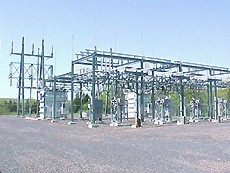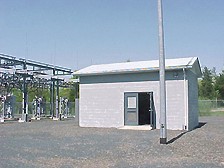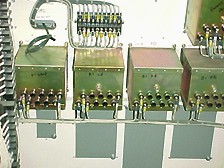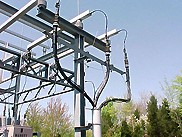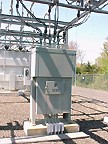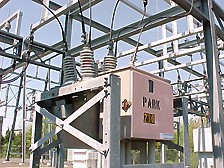East
Rockhill Substation
All substations take in energy and break
it down. Substations all consists of all transformers. All or
most transformers are very similar; they all take in energy and
break it down. They take energy from a bigger substation and send
it into the transformer and it break it down to a lower voltage.
|
|
|
| This is a picture
of the East Rockhill Substation of Perkasie Electric. It uses transformers
to break down the energy and send it to the community. |
|
Power purchased
from Pennsylvania Power and Light (PPL) comes into the substation on large
wires. |
| |
|
|
| A control room is
filled with gauges and dials monitoring the system. |
|
Parts of the system
can be turned on or off in the control room. |
Most substations have the similar equipment;
substations have power lines, pipes, control boxes, switches to
control the amount of energy going out, and many different sizes
of transformers. They always have a back up line to make sure
that everyone still gets the electricity that they need.
Back up lines are also used if the regular
line is broken or not working. Fuse box protectors are also used
so that they don't break up the energy flow.
| Above the substations
are rods called Lightning Arresters. They are a major part of
this substation. If they are struck by lightning, these rods
prevent the lightning from reaching the ground and from destroying
the entire substation or from blowing up any transformers. |
 |
On the poles near the substation, wires
are extended, and they are connected to the substation. There
are three wires per pole: 'A' phase, 'B' phase, and 'C' phase.
The wires carry 69,000 volts through the area. It is parallel
with Pennsylvania Power & Light (PPL) Electric.
TRANSFORMERS
Transformers may be affected by the weather.
On hot days (example - over 85 degrees) the oil inside the transformer
rises. So there is a gap inside of the transformer. They use hydrogen
to fill that gap. On cold days, the oil gets lower inside of the
transformer, so there is a gap in there. So again they put hydrogen
inside of the transformer.
All transformers at the East Rockhill substation
basically work the same way. For each transformer, you will have
to take a certain number of voltage in and a certain number out.
However, with 69000 volt transformers, you need nitrogen to prevent
moisture occurring in the transformer tank.
 |
|
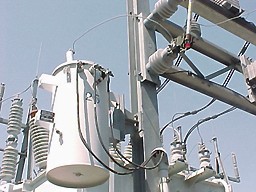 |
| At the
substations, big transformers break energy down to put it into smaller
lines; the electricity is taken to another transformer to break down the
energy again, and the process repeats itself until as it takes the electricity
out to homes and businesses. |
|
Some
of these transformers have thin oil, also. At the top of the transformers,
there is an air gap and it is constant. On a very hot day, the oil heats
up and rises. However, on a cold day, the oil level lowers. This gap prevents
the oil from exploding. Another thing, there is a "pressure release
valve" that actually releases pressure to prevent explosion. |
DANGER - HIGH VOLTAGE !
There are many dangers at an electrical
substation. For this reason, people are protected from the large
quantities of electricity at the substation by security fences
and warning signs. Birds flying into a transformer, or squirrels
jumping from a tree onto a transformer, will not survive the shock.
|
|
|
|
|
| As the electricity
is transformed it is divided. |
|
Electricity
is sent out to different sections of the service area. |
|
This section
of the substation shows part of a large circuit that goes to the Park
Avenue section of Perkasie., PA. |
